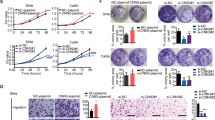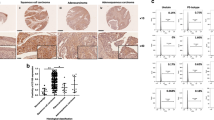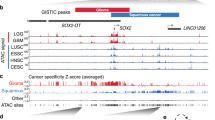Abstract
Mutations in Smads, intermediates of transforming growth factor-β signaling, are known to contribute to the loss of sensitivity to transforming growth factor-β, a common feature of many neoplastic cells. However, not much information is available on Smad alterations in cervical cancer and so we probed, for the first time, for alterations in Smad 2 and Smad 4 genes using human cervical cancer cell lines and human cervical tissue samples. Using PCR/reverse transcription–PCR, single-stranded conformation polymorphism analysis and DNA sequencing, we observed a deletion of ‘G’ in the L3 loop (crucial in Smad–receptor interaction) in C-33A cells, and an insertion of ‘A’ in codon 122 (loss of MH2 domain) from a cervical tumor sample, both of which caused frame shift and pretermination in Smad 2. In addition, a G/A transition at 31 bp upstream-nontranslated regions of exon 8 of Smad 4 was found in Bu 25TK cells. Smad 2 expression was less in some of the cervical tumor samples than that of nonmalignant samples and six cancer samples showed C-terminal deletions that abolish Smad 2 phosphorylation sites. The loss of expression of Smad 4 found in some cervical tumor samples was due to transcription loss rather than deletion of the gene. Our results highlight an important role for Smad 2 and Smad 4 in human cervical tumors.
This is a preview of subscription content, access via your institution
Access options
Subscribe to this journal
Receive 50 print issues and online access
$259.00 per year
only $5.18 per issue
Buy this article
- Purchase on Springer Link
- Instant access to full article PDF
Prices may be subject to local taxes which are calculated during checkout





Similar content being viewed by others
Abbreviations
- TGF-β:
-
transforming growth factor-β
- TβRI:
-
transforming growth factor receptor type I
- TβRII:
-
transforming growth factor receptor type II
- RT–PCR:
-
reverse transcription–PCR
- SQRT–PCR:
-
semiquantitative reverse transcription–PCR
- EMSA:
-
electrophoretic mobility shift assay
- SSCP:
-
single-strand conformation polymorphism
- CIN:
-
cervical intraepithelial neoplasia
- LSIL:
-
low-grade squamous intraepithelial lesion
- HSIL:
-
high-grade squamous intraepithelial lesion
- SCC:
-
squamous cell carcinoma
References
Abdollah S, Macias-Silva M, Tsukazaki T, Hayashi H, Attisano L and Wrana JL . (1997). J. Biol. Chem., 272, 27678–27685.
Attisano L and Wrana JL . (2002). Science, 296, 1646–1647.
Barabas E, Nagy K, Varkonyi V and Horvath A . (2001). Braz. J. Med. Biol. Res., 34, 1271–1275.
Barbera VM, Martin M, Marinoso L, Munne A, Carrato A, Real FX and Fabre M . (2000). Biochim. Biophys. Acta, 1502, 283–296.
Bevan S, Woodford-Richens K, Rozen P, Eng C, Young J, Dunlop M, Neale K, Phillips R, Markie D, Rodriguez-Bigas M, Leggett B, Sheridan E, Hodgson S, Iwama T, Eccles D, Bodmer W, Houlston R and Tomlinson I . (1999). Gut, 45, 406–408.
Bindereif A and Green MR . (1987). EMBO J., 6, 2415–2424.
Cain JM and Howett MK . (2000). Science, 288, 1753–1755.
Chu TY, Lai JS, Shen CY, Liu HS and Chao CF . (1999). Int. J. Cancer, 80, 506–510.
Costentin L, Pages P, Bouisson M, Berthelemy P, Buscail L, Escourrou J, Pradayrol L and Vaysse N . (2002). Pancreatology, 2, 17–25.
de Caestecker MP, Piek E and Roberts AB . (2000). J. Natl. Cancer Inst., 92, 1388–1402.
Dellas A, Torhorst J, Jiang F, Proffitt J, Schultheiss E, Holzgreve W, Sauter G, Mihatsch MJ and Moch H . (1999). Cancer Res., 59, 3475–3479.
Eppert K, Scherer SW, Ozcelik H, Pirone R, Hoodless P, Kim H, Tsui LC, Bapat B, Gallinger S, Andrulis IL, Thomsen GH, Wrana JL and Attisano L . (1996). Cell, 86, 543–552.
Hahn SA, Hoque AT, Moskaluk CA, da Costa LT, Schutte M, Rozenblum E, Seymour AB, Weinstein CL, Yeo CJ, Hruban RH and Kern SE . (1996). Cancer Res., 56, 490–494.
Heldin CH, Miyazono K and ten Dijke P . (1997). Nature, 390, 465–471.
Hilgers W, Song JJ, Haye M, Hruban RR, Kern SE and Fearon ER . (2000). Genes Chromosomes Cancer, 27, 353–357.
Howe JR, Roth S, Ringold JC, Summers RW, Jarvinen HJ, Sistonen P, Tomlinson IP, Houlston RS, Bevan S, Mitros FA, Stone EM and Aaltonen LA . (1998). Science, 280, 1086–1088.
Jayaraman L and Massague J . (2000). J. Biol. Chem., 275, 40710–40717.
Kaneko H, Horiike S, Sasai Y, Iwai T, Nakao M, Yokota S, Taniwaki M, Kashima K and Misawa S . (1998). Acta Haematol., 99, 187–190.
Kang SH, Won K, Chung HW, Jong HS, Song YS, Kim SJ, Bang YJ and Kim NK . (1998). Int. J. Cancer, 77, 620–625.
Kim SK, Fan Y, Papadimitrakopoulou V, Clayman G, Hittelman WN, Hong WK, Lotan R and Mao L . (1996). Cancer Res., 56, 2519–2521.
Kong XT, Choi SH, Inoue A, Xu F, Chen T, Takita J, Yokota J, Bessho F, Yanagisawa M, Hanada R, Yamamoto K and Hayashi Y . (1997). Cancer Res., 57, 3772–3778.
Lee S, Cho YS, Shim C, Kim J, Choi J, Oh S, Zhang W and Lee J . (2001). Int. J. Cancer, 94, 500–507.
Liu F, Pouponnot C and Massague J . (1997). Genes Dev., 11, 3157–3167.
Lo RS, Chen YG, Shi Y, Pavletich NP and Massague J . (1998). EMBO J., 17, 996–1005.
Lohmann DR, Brandt B, Hopping W, Passarge E and Horsthemke B . (1996). Am. J. Hum. Genet., 58, 940–949.
MacGrogan D, Pegram M, Slamon D and Bookstein R . (1997). Oncogene, 15, 1111–1114.
Maitra A, Molberg K, Albores-Saavedra J and Lindberg G . (2000). Am. J. Pathol., 157, 1105–1111.
Miyaki M, Iijima T, Konishi M, Sakai K, Ishii A, Yasuno M, Hishima T, Koike M, Shitara N, Iwama T, Utsunomiya J, Kuroki T and Mori T . (1999). Oncogene, 18, 3098–3103.
Mullokandov MR, Kholodilov NG, Atkin NB, Burk RD, Johnson AB and Klinger HP . (1996). Cancer Res., 56, 197–205.
Muro-Cacho CA, Rosario-Ortiz K, Livingston S and Munoz-Antonia T . (2001). Clin. Cancer Res., 7, 1618–1626.
Nguyen HN and Nordqvist SR . (1999). Semin. Surg. Oncol., 16, 217–221.
Osawa H, Shitara Y, Shoji H, Mogi A, Kuwano H, Hagiwara K and Takenoshita S . (2000). Int. J. Oncol., 17, 723–728.
Patel SA, Adams R, Goldstein M and Moskaluk CA . (2002). Am. J. Surg. Pathol., 26, 1071–1077.
Salovaara R, Roth S, Loukola A, Launonen V, Sistonen P, Avizienyte E, Kristo P, Jarvinen H, Souchelnytskyi S, Sarlomo-Rikala M and Aaltonen LA . (2002). Gut, 51, 56–59.
Schoell WM, Janicek MF and Mirhashemi R . (1999). Semin. Surg. Oncol., 16, 203–211.
Schutte M, Hruban RH, Hedrick L, Cho KR, Nadasdy GM, Weinstein CL, Bova GS, Isaacs WB, Cairns P, Nawroz H, Sidransky D, Casero Jr RA, Meltzer PS, Hahn SA and Kern SE . (1996). Cancer Res., 56, 2527–2530.
Tanaka S, Mori M, Mafune K, Ohno S and Sugimachi K . (2000). Br. J. Cancer, 82, 1557–1560.
ten Dijke P, Miyazono K and Heldin CH . (2000). Trends Biochem. Sci., 25, 64–70.
Tsukazaki T, Chiang TA, Davison AF, Attisano L and Wrana JL . (1998). Cell, 95, 779–791.
Uchida K, Nagatake M, Osada H, Yatabe Y, Kondo M, Mitsudomi T, Masuda A and Takahashi T . (1996). Cancer Res., 56, 5583–5585.
Woodford-Richens KL, Rowan AJ, Gorman P, Halford S, Bicknell DC, Wasan HS, Roylance RR, Bodmer WF and Tomlinson IP . (2001). Proc. Natl. Acad. Sci. USA, 98, 9719–9723.
Xie W, Mertens JC, Reiss DJ, Rimm DL, Camp RL, Haffty BG and Reiss M . (2002). Cancer Res., 62, 497–505.
zur Hausen H . (1996). Biochim. Biophys. Acta, 1288, F55–F78.
Acknowledgements
We thank Dr PK Shyamala Devi for providing fresh cervical tissues, and Dr Balaraman Nair, Ms Indu Ramachandran and Ms Sheela for technical advice and help. A research grant from the Department of Science and Technology (to DK), program support to the Rajiv Gandhi Center by the Department of Biotechnology, a Research Associate Fellowship (to AN) and a Senior Research Fellowship (to TTM) by the Council of Scientific and Industrial Research, Government of India are gratefully acknowledged.
Author information
Authors and Affiliations
Corresponding author
Rights and permissions
About this article
Cite this article
Maliekal, T., Antony, ML., Nair, A. et al. Loss of expression, and mutations of Smad 2 and Smad 4 in human cervical cancer. Oncogene 22, 4889–4897 (2003). https://doi.org/10.1038/sj.onc.1206806
Received:
Revised:
Accepted:
Published:
Issue Date:
DOI: https://doi.org/10.1038/sj.onc.1206806
Keywords
This article is cited by
-
The functional role of circular RNAs in the pathogenesis of retinoblastoma: a new potential biomarker and therapeutic target?
Clinical and Translational Oncology (2023)
-
SMAD2 rs4940086 heterozygosity increases the risk of cervical cancer development among the women in Bangladesh
Molecular Biology Reports (2020)
-
Transforming growth factor-β1 in carcinogenesis, progression, and therapy in cervical cancer
Tumor Biology (2016)
-
Partial loss of Smad signaling during in vitroprogression of HPV16-immortalized human keratinocytes
BMC Cancer (2013)
-
Roles of TGFβ signaling Smads in squamous cell carcinoma
Cell & Bioscience (2011)



